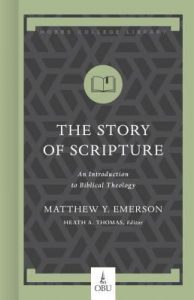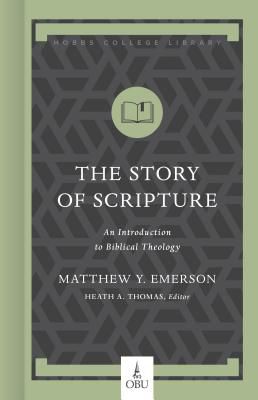Emerson, Matthew Y. The Story of Scripture: An Introduction to Biblical Theology. Nashville, TN: B&H Academic, 2017, $19.99, hardcover.
Matthew Emerson (Ph.D. Southeastern Baptist Theological Seminary) is associate professor of religion and holds the Dickinson Chair of Religion at Oklahoma Baptist University in Shawnee, Oklahoma. Emerson’s work in this volume is a part of the Hobbs College Library Collection at Oklahoma Baptist University which promises to offer additional volumes in the areas of Bible, theology, and Christian ministry. In under one hundred pages, Emerson captures the essence of biblical theology for those training for Christian ministry.
Consisting of six succinct chapters, the book begins with a helpful introduction to the discipline of biblical theology in its historical and academic background. Anyone new to this field will appreciate Emerson’s overview and clarity. Following an evaluation of Johannes Gabler’s contribution to the discipline, Emerson explains three primary schools or approaches: the Dallas School which focuses attention on the Israel/Church relationship; the Chicago School which seeks to understand how any given text fits within the overall biblical narrative; the Philadelphia School which asks similar questions of the previous approaches, but also investigates aspects of literary context.
Emerson then moves beyond these helpful categories to summarize key points of theological importance (the Trinitarian shape of Scripture, for example), to the critical issues of biblical unity. In the end, he adopts helpful metaphors to explain how “the whole Bible is one book inspired by one author with one story that culminates in one person, the God-Man Jesus Christ. Biblical theology is the attempt to read the Bible in this structurally and conceptually unified fashion” (pp. 16-17).
In chapters two-four, Emerson covers the overall story of the Bible. Chapter two employs a Creation, Fall, Redemption, Redemption Promised structure. Careful attention is given to the major personalities and events within this structure. Chapter three continues this exploration with attention given to the redemptive arc from the Exodus to the Davidic kingdom and the hopeful message of the prophets. Chapter four traces these themes in their New Testament context as the promised deliverer is presented and his redemption accomplished. Chapter five, perhaps the real gem of the book, helpfully takes readers below the major themes from the previous chapters to the underlying theological concepts one must consider in constructing a consistent biblical theology. For example, one’s understanding of covenant, kingdom, mission, and salvation have to be aligned, and Emerson seeks to assist one is this task. In chapter six, the final chapter, Emerson integrates biblical theology into various practical applications.
As much as this work is a primer on the overall discipline of biblical theology, it would be accurate to describe it as a summary of the Bible’s main storyline, complete with character summaries, geographical explanations, and the personal application of the Bible’s message to individuals. For strengths, one could note at least three. One, for a volume of this brevity (in total, the book is less than one hundred pages), Emerson succeeds in presenting a lot of information. Two, readers will no doubt be helped by the helpful footnotes where Emerson points to more substantive treatments of the themes in question. Three, perhaps the unique feature of the book, Emerson ends his volume by urging readers to incorporate the Bible’s message into proclamation. The brief sections on preaching and teaching, doctrine, counseling, and devotion add a unique flavor to a book in this field. The benefit of this import certainly resides in the nudging of readers to recognize the immediate application of biblical theology for all of life.
Perhaps the book’s greatest weakness is the opposite of a strength mentioned above. If viewed as a primer, this volume satisfies what one would expect to encounter, and it even exceeds expectations for the reasons listed above. If readers are seeking depth and an engagement with more secondary issues of the subject matter, then this volume will not suffice. To be clear, however, Emerson’s approach is one of introductory investigation and not one of issuing forth the next tome to redirect or satisfy the current debates within the field.
In addition to Emerson’s volume, students should consult any one of the following volumes for further introductory treatments: T. Desmond Alexander’s, From Eden to the New Jerusalem: An Introduction to Biblical Theology (Kregel, 2009), and James Hamilton’s What Is Biblical Theology?: A Guide to the Bible’s Story, Symbolism, and Patterns (Crossway, 2013). Each of these proven works are suitable introductions to complement Emerson’s primer. Additionally, for more in depth treatments, students should consider working through Graeme Goldsworthy’s Christ-Centered Biblical Theology: Hermeneutical Foundations and Principles (IVP, 2012), G. K. Beale’s A New Testament Biblical Theology: The Unfolding of the Old Testament in the New (Baker, 2011), and especially the standard work of Geerhardus Vos in Biblical Theology: Old and New Testaments (Banner of Truth, 2014). Each of these authors, while disagreeing on various points and approaches, approach biblical theology with precision and nuance as each seeks to explain the Bible’s unity and purpose.
In the end, Emerson has brought together a concise primer where he introduces readers to the terminology and terrain of biblical theology. Readers new to this subject will benefit from his concise and engaging approach.
Justin L. McLendon
Phoenix, AZ





